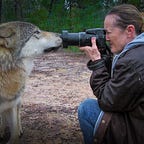The Plight of Panthera Leo
And What We Can Do About It
Do you really want to live in a world without lions?
I don’t.
The thought of it is heartbreaking to me.
And yet, Panthera leo is considered vulnerable, on the “red list” of threatened species. From numbers that used to exceed 200,000 they’ve been cut to barely 20,000.
They are now present in only 20% of their historical range.
Folks…think about the considerable destruction that implies, with almost every threat to them being human in origin.
What, you say, could threaten the king of beasts?
Let’s talk about that.
Human population growth and expansion fragments their territory, decreases prey available for their survival, and increases human-lion conflicts when lions must resort to livestock for food.
The illegal bushmeat trade in other animals decreases food sources available to them. It also sometimes ensnares lions in cruel traps that can mean a painful and slow death.
Asian markets supporting poaching specifically for lion products.
Canned hunting is an incredibly cruel practice in which lions are bred specifically for “trophy” hunting. They are raised in conditions that are unnatural and unethical, all to feed the financial gluttony of some humans.
During my recent visit to Tanzania, I was incredibly moved by this magnificent species, having had the privilege to witness them in myriad stages of their life cycle and situations.
Subsequently, I feel compelled to speak out, and help educate people regarding their plight, and to attempt to garner support for the cause of substantially increasing the lion population.
What can we do about these things? It all seems too overwhelming, but we cannot allow that to paralyze us.
First, we must increase awareness. When you learn of these statistics and unethical practices, pass on what you’ve learned.
When you appreciate lions in photography and art, share it, so they may come into the hearts of others.
Be mindful of how you spend your dollars. It’s great that eco-tourism is on the rise, yet having “eco” as a descriptive doesn’t always translate to ethical and professional practices. I witnessed far too many “guides” interfering in lioness & pride hunting by pulling their vehicles between a lioness and her prey, attempting to obtain better viewing for their tourists. While wildlife enthusiasts may be well-meaning, they too can be a detriment if not mindful of their potential impact on wild populations.
Speak out against those who would hunt lions for sport and “trophy.” We must make our voices louder and our dollars greater than theirs. My guide said to me “We need your help. We need the help of places like the United States. It can be illegal to trophy hunt animals here, but we need it to be illegal there too…otherwise people find too many ways around the law…” They don’t need foreigners coming to hunt a for a once live decoration.
Absolutely refuse to use products or buy from any company or individual that supports wildlife trade. You don’t need lion bone for your health! To the contrary, we need lions for a healthy planet!
Support organizations that promote the welfare and conservation of lions and other wildlife. It is believed that we can double or triple the numbers if we simply protect their current territories. Their territories will have to be managed, but this is feasible. There are organizations that have strategic plans for this. We simply have to garner and sustain the support for them.
Learn about community based conservation, where local villagers are assisted by organizations, such as KopeLion, to protect and preserve the lion population:
Take 10 minutes to listen to native Zambian and lion biologist Thandiwe Mweetwa:
My small, but ongoing mission is to attempt to help people love and appreciate all animals. I take pictures and make artwork, and I hope that people will be drawn to the magnificent subjects of my work.
I also donate those photos and proceeds directly to conservation and rehabilitation organizations.
As a matter of fact, I’m going to do a lion recovery initiative of my own. I’m going to be processing my photo safari images for years to come, and I’m going to offer lion prints for sale, and donate 100% of the proceeds to lion conservation organizations, such as The Lion Recovery Fund. And if you want proof, I’ll prove to you that I donated the money. That’s the least I can do.
There is hope, beautiful people. It has been determined that we can turn this thing around. We can have a world with a healthy lion population. But we must start now, before it is too late.
The best places to see my lion images are:
But I have an even better way of getting photo prints to folks in a much more affordable way. I have them printed and sent for a fraction of the cost of purchasing from sites like my Fine Art America site. They do a fantastic job! But, there are other options that help when discretionary funds are slim.
In Africa, Disney’s Lion King was mentioned to me several times, and I was told it had done wonders for awareness and conservation. So get out there and see it. I already have my ticket for next week!
Let’s spread the love of Panthera leo!
